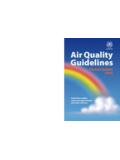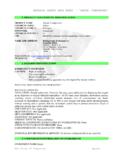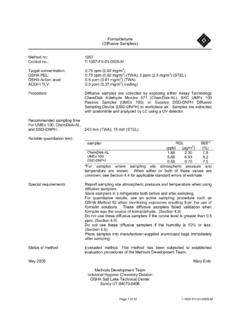Transcription of STATE OF GLOBAL AIR/2019
1 The STATE of GLOBAL Air is a collaboration between the Institute for Health Metrics and Evaluation s GLOBAL Burden of Disease Project and the Health Effects OF GLOBAL AIR/2019A SPECIAL REPORT ON GLOBAL exposure TO AIR POLLUTION AND ITS DISEASE BURDEN The STATE of GLOBAL Air is a collaboration between the Health Effects Institute and the Institute for Health Metrics and Evaluation s GLOBAL Burden of Disease : Health Effects Institute. 2019. STATE of GLOBAL Air 2019. Special Report. Boston, MA:Health Effects 2578-6873 2019 Health Effects InstituteWhat is the STATE of GLOBAL Air? The STATE of GLOBAL Air report brings into one place the latest information on air quality and health for countries around the globe. It is produced annually by the Health Effects Institute and the Institute for Health Metrics and Evaluation s GLOBAL Burden of Disease project as a source of objective, peer-reviewed air quality data and analysis.
2 Like previous reports, this year s publication presents infor-mation on outdoor and household air pollution and on the health impacts of exposure to air pollution. For the first time, the report also explores how air pollution affects life expectancy. Who is it for?The report is designed to give citizens, journalists, policy mak-ers, and scientists access to reliable, meaningful information about air pollution exposure and its health effects. The report is free and available to the public. How can I explore the data?This report has a companion interactive website that provides tools to explore, compare, and download data and graphics with the latest air pollution levels and associated burden of disease. Anyone can use the website to access data for 195 individual countries or territories and their related regions, as well as track trends from 1990 to 2017.
3 Find it at will I find information on:Introduction ..page 1 exposure to Air Pollution ..page 3 Household Air Pollution ..page 8 The Burden of Disease from Air Pollution ..page 11 Air Pollution s Impact on Life Expectancy ..page 16 Conclusions ..page 19 Additional Resources ..page 20 Contributors and Funding ..page 22 1 STATE OF GLOBAL AIR / 2019 Our health is strongly influenced by the air we breathe. Poor air quality causes people to die younger as a re-sult of cardiovascular and respiratory diseases, and also exacerbates chronic diseases such as asthma, causing people to miss school or work and eroding quality of life. Air pollution affects the young and the old, the rich and the poor, and people in all areas of the globe. Research over the past several decades has revealed a multitude of ways in which poor air quality affects our health and quality of life, and scientists continue to learn more.
4 Studies have also continued to illuminate the causes of air pollution, helping us understand why air quality is worse in some places and better in others. This publication, the third annual STATE of GLOBAL Air report, presents the latest information on worldwide air pollution exposures and health impacts. It draws from the most recent evidence produced as part of the GLOBAL Burden of Dis-ease (GBD) project of the Institute for Health Metrics and Evaluation (IHME) (see textbox Improving GLOBAL Bur-den of Disease Estimates with New and Better Data ). The STATE of Glob-al Air report is produced by the Health Effects Institute (HEI).Building on previous STATE of Glob-al Air reports, this publication offers a GLOBAL update on outdoor (ambient) air pollution and on household air pollution from use of solid fuels for cooking.
5 To track outdoor air quality, the report focuses on the concentra-tions of two pollutants in particular: fine particle air pollution (particulate matter measuring less than mi-crometers in aerodynamic diameter, or ) and ozone found near ground level (tropospheric ozone). This as-sessment also tracks exposure to household air pollution from burning fuels such as coal, wood, or biomass for cooking. These forms of air pollu-tion are considered key indicators of INTRODUCTIONAir pollution is the fifth leading risk factor for mortality worldwide. It is responsible for more deaths than many better-known risk factors such as malnutrition, alcohol use, and physical inactivity. Each year, more people die from air pollution related disease than from road traffic injuries or malaria. Figure 1.
6 GLOBAL ranking of risk factors by total number of deaths from all causes for all ages and both sexes in the rankings further at the IHME/GBD Compare site. 2 STATE OF GLOBAL AIR / 2019 IMPROVING GLOBAL BURDEN OF DISEASE ESTIMATES WITH NEW AND BETTER DATA: ANNUAL UPDATESD espite some differences, the estimates of air pollution health burden from multiple analyses consistently show that air pollution has a large impact on population health. As the science continues to advance, the GBD project has incorpo-rated new data and methodology into its air pollution and health assessments. This year s STATE of GLOBAL Air report presents updated information for all of the indicators addressed in previous new methodology may result in differences between as-sessments from previous years, trends over time are recalculated with each update to ensure the findings are internally consistent within each report.
7 These updates help ensure that each assessment provides the most accurate information available based on rigorous scientific methods: Eliminating double counting. This year s report analyzes the burden of disease from ambient air pollution independently from that of household air pollution. Past estimates had the potential for some double counting of the disease burden in populations exposed to both ambient and household air pollution. New methods for analyzing health impacts from exposures. The mathematical methods for analyzing how exposure to pollution relates to specific health risks (known as exposure response functions) have been updated. The new methods reflect data from recent epidemiological studies on the impacts of ambient , household air pollution and secondhand smoke and from updated literature reviews on the impacts of active smoking.
8 New methods for assessing ozone. The method for estimat-ing ozone concentrations has been revised, incorporating for the first time an extensive database of ground-level ozone measurements. In addition, the ozone exposure metric was changed to an 8-hour daily maximum level to align with more recent epidemiological analyses. Inclusion of more measurements. The database of ground measurements of has been expanded from approximately 6,000 to 9,960 sites. Including more measurements in the models used to calibrate satellite-based estimates results in finer-grained estimates of concentrations that vary more smoothly and realistically over space and time. In addition, es-timates of exposure now directly incorporate uncertainty distributions from the calibration model. Of these changes, those related to eliminating double counting and the updating of exposure response functions have the largest impact on the disease burden estimates.
9 For more information about these changes, please refer to the Additional Resources. Other groups have estimated the burden of air pollution on human health as concern over air pollution has grown. Most notably, the World Health Organization (WHO) has long made its own periodic estimates, with the most recent analysis (of 2016 data) released in early 2018. IHME, the primary source of information for this report, is the only organization that updates its estimates annually; its methods are increasingly being adopted by others, including the WHO. Given the complexity of the process for developing these estimates, some variation is not surprising. However, as the methods used by different organizations converge, this variability is expected to diminish. air quality, and each contributes to the collective impact of air pollu-tion on human health.
10 Air pollution consistently ranks among the top risk factors for death and disability worldwide. Breathing polluted air has long been recognized as increasing a person s chances of developing heart dis-ease, chronic respiratory diseases, lung infections, and cancer. In 2017, air pollution was the fifth highest mortality risk factor globally and was associated with about million deaths and 147 million years of healthy life lost (Figure 1). This report summarizes the latest evidence on the health impacts of air pollution and discusses how these health impacts affect how long, and how well, people live. WHAT S NEW THIS YEAR? Assessing impacts on life expectancy. Life expectancy a measure of how long a person can expect to live has always been an important indicator of the health of a society. This year, the STATE of GLOBAL Air features an analysis of how much air pollution reduces life expectancy in countries around the world.




